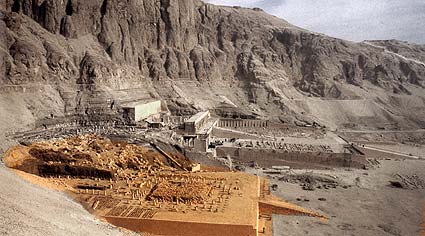 statue of Mentuhotep
II from his temple/tomb statue of Mentuhotep
II from his temple/tomb |
The tomb within
the temple
In the centre of the court the entrance to the burial shaft for
Mentuhotep's tomb begins as a rectangular trench. The trench
becomes a tunnel through the rock of the mountain, the first
part of the tunnel clad in sandstone with niches that once held
wooden human models showing them working in bakeries, granaries
and ships.
The tunnel descends 150m and ends in a burial chamber 44.9m below
the court. The chamber held an alabaster shrine (taking up three-quarters
of the room), this shrine once held the wooen coffin of Mentuhotep
II.
The
Gate of the Horseman
In the plain in front of the temple is an entrance to a deep
tunnel which leads to a chamber beneath the temple.
Other burials at the
temple:
The Tombs of the Royal Ladies
In 1920 shrines and shaft tombs belonging to 6 women belonging
to the royal circle:
Henhenet, Kemsit, Kawit, Sadeh, Ashayt and Muyet.
All were under 20 years old (Muyet the youngest was about 5)
Burials surrounding the temple:
many other burials from the period have also been found near
to the temple/tomb of Mentuhotep II:
Queen Tem (mother of Mentuhotep III), Queen Neferu (Mentuhotep
II's wife and sister). The chancellor Akhtoy, viziers Dagi and
Ipi, the Chief Steward Henenu. (Dagi's impressive limestone sarcophagus
had a full version of the Coffin Texts)
Also nearby was a mass tomb of 60 soldiers killed who were killed
in battle - most likely in Nubia. All had been shot by missiles
falling from above, the few that had only been wounded were killed
by a blow to the head. Marks on the bodies by birds of prey show
that the bodies were left on the battlefield for some time before
they had been recovered for burial.
|


